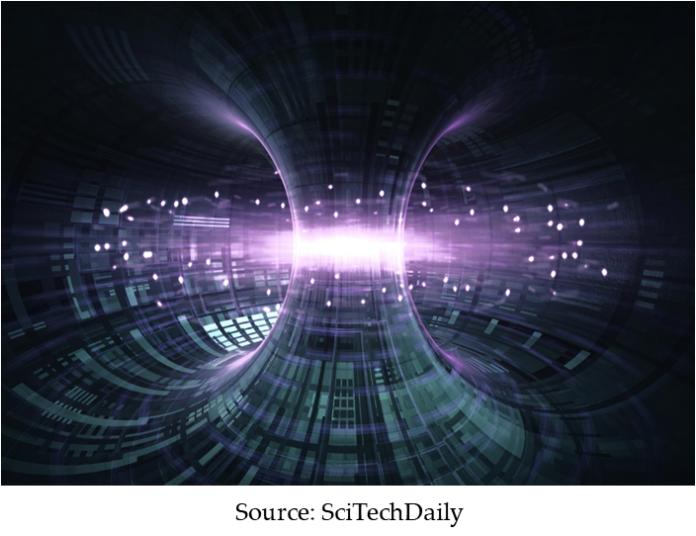By Simon Li and Jonah Ruddock
Rising sea levels, increasing temperatures, and spikes in extreme weather are all being caused by man-made pollution of carbon dioxide and other greenhouse gases into our atmosphere. (At least the economy is doing great!) As our society heads towards its doom, scientists are scrambling to find alternative energy sources for the future. Solar, geothermal, hydro, and wind power are already potential candidates to replace fossil fuels, but their energy output is severely lacking as of now.
In steps nuclear energy, the eccentric hipster your parents tell you to avoid on the streets. Their thinking is based in some fact–nuclear energy has a stigma for being unsafe, dangerous, and hazardous not only to individuals but to the environment as well (after all, we all know about Chernobyl). This partially stems from the fact that, due to a lack of investment in new energy infrastructure, many nuclear reactors we see today are outdated and unsafe models. However, a crucial piece of the truth has been hidden. Much like Janus from ancient Roman mythology, nuclear energy has two faces–fission, the breaking down of elements, and fusion, the building up of elements.
What is fusion?
Nuclear fusion is vastly different from its foil, fission, whose radioactive byproducts have gaslighted fusion into
doubting its abilities. Unlike its toxic sibling, fusion would be able to generate massive amounts of energy without producing any radioactive byproducts. The only byproduct produced by fusion, shockingly, would be helium gas.
Fusion is also the process by which the sun generates energy, where four hydrogen atoms fuse together to four helium. As stars grow larger, they begin to synthesize larger and heavier elements. However, the extreme temperatures and pressures required for these reactions make them, at this time, impossible to achieve on earth.
However, decades of research have been chipping away at the obstacles in the way of making fusion a reality. Just recently, two exciting breakthroughs in fusion energy have been released to the world like Prometheus’s fire to humankind or Mr. Kubiak’s snow day emails to the East faculty. Unfortunately, both of these developments come from the Brits–and they’re almost as good as opium.
Records Broken By JET
On February 9th, scientists in England reported a new record for energy generated by fusion with Joint European Torus.
Like the famous ITER, the Joint European Torus (JET) is a tokamak generator, which is a circular vessel wrapped around an electromagnetic coil. Here, hydrogen isotopes, contained by a magnetic field, are heated to extremely high temperatures. This heat increases the speed at which the isotopes move, causing their nuclei to smash together in the most intense game of partner dodgeball in the world. JET has been using tritium and deuterium instead of the usual protium. These forms of hydrogen have additional neutrons, which makes reactions easier and the reactor more successful.
Back in December of 2021, JET was able to generate 59 megajoules of energy for five full seconds. This destroyed previous records–for comparison, in 2020, the National Ignition Facility in California had celebrated a fusion ignition that generated just 1.3 megajoules of energy.
Every fusion reactor’s goal is to generate more energy than is required to operate it, what scientists call productive fusion. This is measured by a “power ratio”, or Q, where Q is the amount of energy generated divided by the amount of energy the reactor requires to operate. The goal would be to have Q be greater than 1, where the amount of energy generated is greater than the energy required. For JET, one of the largest reactors in the world today, 59 megajoules is .33Q. While it hasn’t broken even yet, it’s an exciting step in the right direction, and the processes applied in JET will hopefully be applied to other reactors, like ITER, sometime in the future.
Promising A.I.
DeepMind, a London-based artificial intelligence software lab owned by Google, claims to have taught an AI system to oversee the workings of a nuclear fusion reactor. This was done through reinforcement learning, a technique where an AI is programmed to act in a way in a given situation that will maximize its chance of receiving a reward. It has undergone around 100 test trials on a reactor at the Swiss Plasma Center. DeepMind’s AI controlled the magnets in the reactor for two seconds (the amount of time the reactor is able to run before overheating). DeepMind reported that their AI is able to adjust the reactor’s voltage thousands of times per second.
DeepMind was founded in 2010 by Demis Hassabis, Shane Legg and Mustafa Suleyman. They began teaching A.I. to play old computer games such as Pong and Space Invaders, which quickly became an expert at said games. Their A.I.s became so powerful that it was able to beat a professional Go (the oldest board game continuously played today) champion in 2016. The goal of DeepMind, according to the founders, is to create a general, multipurpose A.I. suited for almost everything (including nuclear fusion).
As pioneering science fiction author William Gibson put it, the future is already here. It is just not very evenly distributed.








